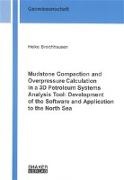Read more
This thesis is subdivided into three main parts:
Part one is an introduction to the essential mathematical, physical and geological methods used in PetroMod'v's full 3D petroleum systems modeling software tool. Therefore, the mathematical description of the finite element method and its implementation into the three dimensional petroleum systems modeling software program is discussed.
Part two considers the derivation of a mudstone compaction model from Aplin and Yang ([Apli97]). The new mechanical compaction model for mudstones allows variations in compaction behavior by defining a special clay fraction of mudstones that can be obtained from log data. While the term mudstone commonly refers to a lithology with a grain size of :::; 2J-Lm it often represents a mixed lithology that may contain varying amounts of clay, silt, and fine sand. The clay content greatly determines the average grain size of mudstones. Furthermore, it is shown that the new compaction algorithm differs from the standard effective stress compaction model only in the definition of the compressibility values.
Part three applies the geological mudstone models to areal case study in the North Sea. The compaction model for mudstones that depends strongly on the clay content of the individual stratigraphic units is mainly used for the calibration of porosities in the 3D case study. In addition, a chemical compaction model that reduces porosities by using a kinetic reaction is applied to the deeper part of the basin
where mechanical compaction processes become less important as compared to mechanical compaction.

